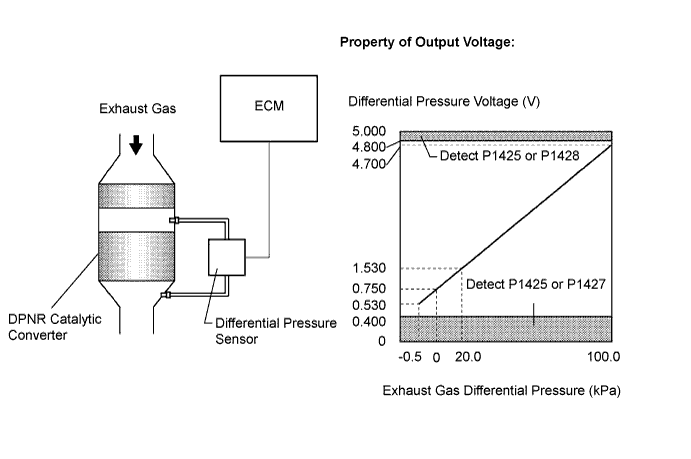Dtc P1426 Differential Pressure Sensor Installation Error
Engine. Lexus Is250, Is220D. Gse20 Ale20
DESCRIPTION
MONITOR DESCRIPTION
INSPECTION PROCEDURE
CHECK OTHER DTC OUTPUT (IN ADDITION TO DTC P1426)
CHECK VACUUM HOSES (CONNECTION OF VACUUM HOSES)
CHECK VACUUM HOSES AND TRANSMITTING PIPES (BLOCKAGE OF VACUUM HOSES AND TRANSMITTING PIPES)
READ VALUE OF DIFFERENTIAL PRESSURE
DTC P1426 Differential Pressure Sensor Installation Error |
DESCRIPTION
- HINT:
- For more information on the differential pressure sensor and TOYOTA D-CAT (*1) (Click here).
- If P1426 is present, refer to the DTC chart for TOYOTA D-CAT (Click here).
- *1: Diesel Clean Advanced Technology.
The two sensing chambers of the differential pressure sensor are mounted to monitor the pressure before and after the DPNR (*2) catalytic converter. The sensor itself is not located on the engine assembly in order to reduce the influence of vibration. The sensor is a semiconductor-type that is not influenced by exhaust gases.The ECM compares the exhaust gas pressure before and after DPNR catalytic converter by monitoring the pressure using the upstream and downstream sensing chambers of the differential pressure sensor. If the difference between the pressure before and after the catalytic converter exceeds a predetermined level, the ECM judges that the catalytic converter has clogged with particulate matter (PM). When the ECM judges that a partially clogged condition exists, the ECM begins to perform DPNR catalyst regeneration.*2: Diesel Particulate-NOx Reduction system- HINT:
- If the vacuum hoses of the differential pressure sensor are incorrectly connected (crossed), the ECM interprets this as abnormal pressure difference, sets DTC P1426 (Differential Pressure Sensor [Installation]) and illuminates the MIL.
DTC No.
| DTC Detection Condition
| Trouble Area
|
P1426
| Output voltage from the differential pressure sensor indicates positive pressure as negative pressure (and vice versa)
(1 trip detection logic)
| - Incorrect differential pressure sensor hose
- Differential pressure sensor vacuum hose is clogged
- Blockage in vacuum transmitting pipe sub-assembly
- Differential pressure sensor
- ECM
|
- HINT:
- DTC P1425 (Differential pressure sensor circuit), DTC P1427 (Differential pressure sensor circuit low) and/or DTC P1428 (Differential pressure sensor high) will be present if there is an open or short malfunction in the differential pressure sensor circuit.
- After confirming DTC P1426, check the differential pressure in the "Powertrain / Engine / Data List / DPNR Differential Pressure" using the intelligent tester.
Reference:Condition
| Differential Pressure Output
| Sensor Condition
|
Engine Switch ON (IG)
| Approximately 0 kPa
| Normal
|
Always
| 3 kPa
| Open or short circuit
|
3,000 rpm (No engine load)
| Negative output
| Incorrect arrangement of hose piping
|
MONITOR DESCRIPTION
In order to detect abnormality in the differential pressure sensor, the ECM always monitors output voltage from the sensor. When the sensor output voltage is a reversal of positive and negative pressure, the ECM interprets this as incorrect vacuum hose arrangement of the sensor, or determines that the vacuum hoses have clogged, thus the MIL will be illuminated.
INSPECTION PROCEDURE
| 1.CHECK OTHER DTC OUTPUT (IN ADDITION TO DTC P1426) |
Connect the intelligent tester to the DLC3.
Turn the engine switch ON (IG) and turn the intelligent tester ON.
Enter the following menus: "Powertrain / Engine / DTC".
Read DTCs.
- Result:
Display (DTC output)
| Proceed to
|
P1426
| A
|
P1426 and other DTCs
| B
|
- HINT:
- If codes other than P1426 are output, perform troubleshooting for those DTCs first.
| 2.CHECK VACUUM HOSES (CONNECTION OF VACUUM HOSES) |
Check if vacuum hose routing between the differential pressure sensor and the vacuum transmitting pipe is correct.
Check that there is no exhaust gas leakage between the differential pressure sensor and the vacuum transmitting pipe.
| 3.CHECK VACUUM HOSES AND TRANSMITTING PIPES (BLOCKAGE OF VACUUM HOSES AND TRANSMITTING PIPES) |
- CAUTION:
- Be careful not to get burned by exhaust gases during the following inspection.
Disconnect the vacuum hose (both upstream and downstream) on the differential pressure sensor.
Start the engine.
Check if there are exhaust gas pulsations from both vacuum hoses during idling.
| 4.READ VALUE OF DIFFERENTIAL PRESSURE |
Connect the intelligent tester to the DLC3.
Turn the engine switch ON (IG) and turn the intelligent tester ON.
Enter the following menus: "Powertrain / Engine / Data List / DPNR Differential Pressure".
Check that differential pressure is within the specification below.
- Result:
Condition
| Differential Pressure Output
| Sensor Condition
|
Engine Switch ON (IG)
| Approximately 0 kPa
| Normal
|
Always
| 3 kPa
| Open or short circuit
|
3,000 rpm (No engine load)
| Negative output
| Incorrect arrangement of hose piping
|
| | CHECK FOR INTERMITTENT PROBLEMS |
|
|
| NG |
|
|
|
| REPLACE DIFFERENTIAL PRESSURE SENSOR ASSEMBLY |
|

